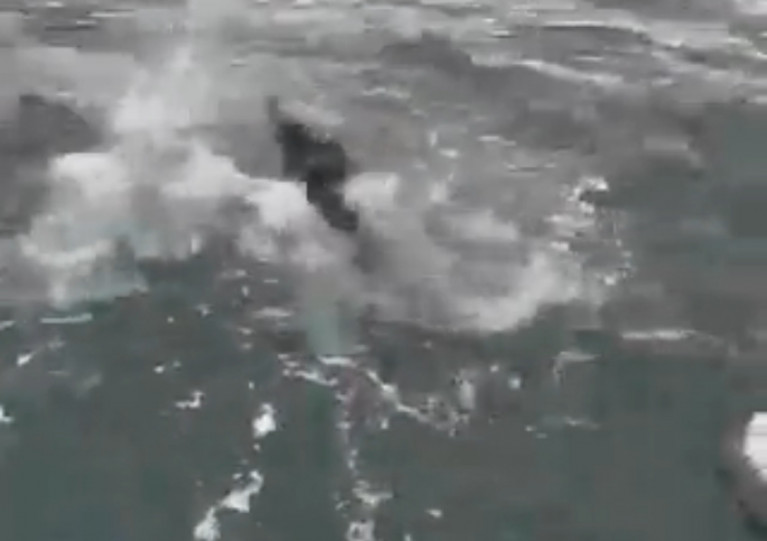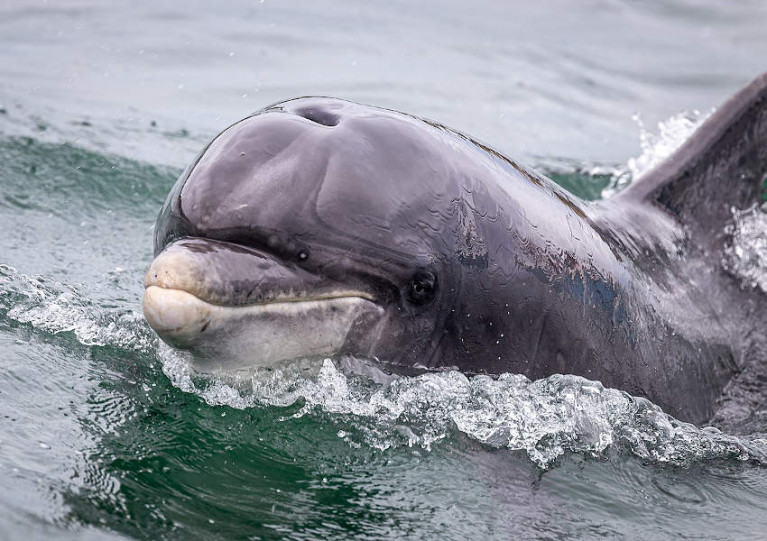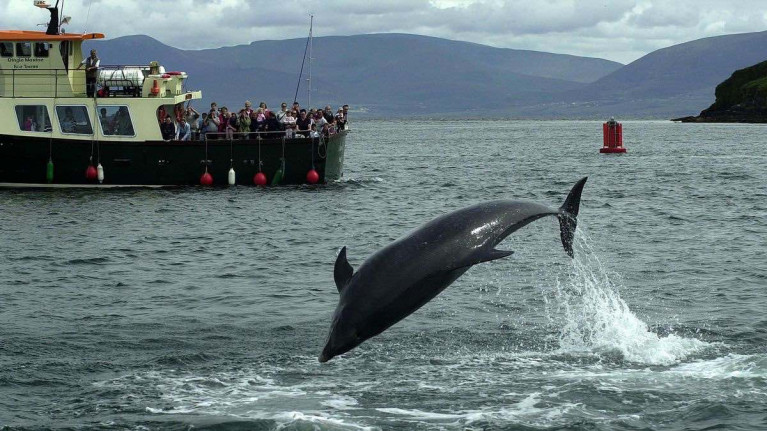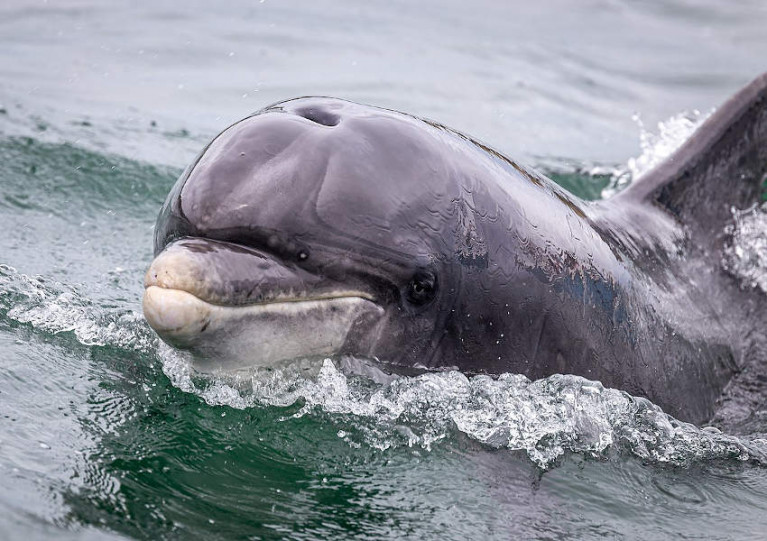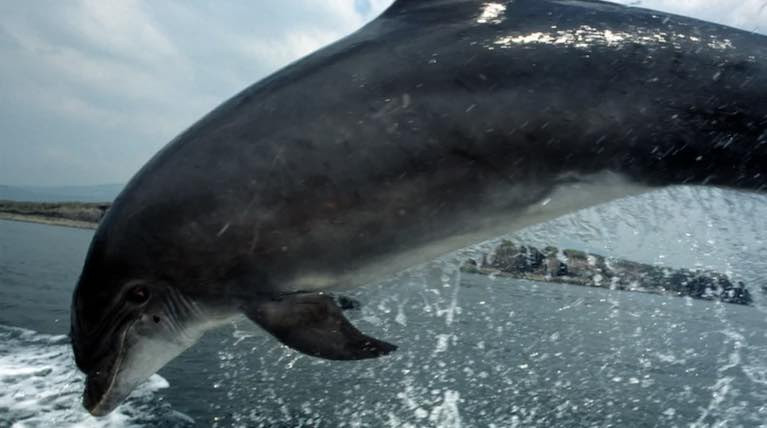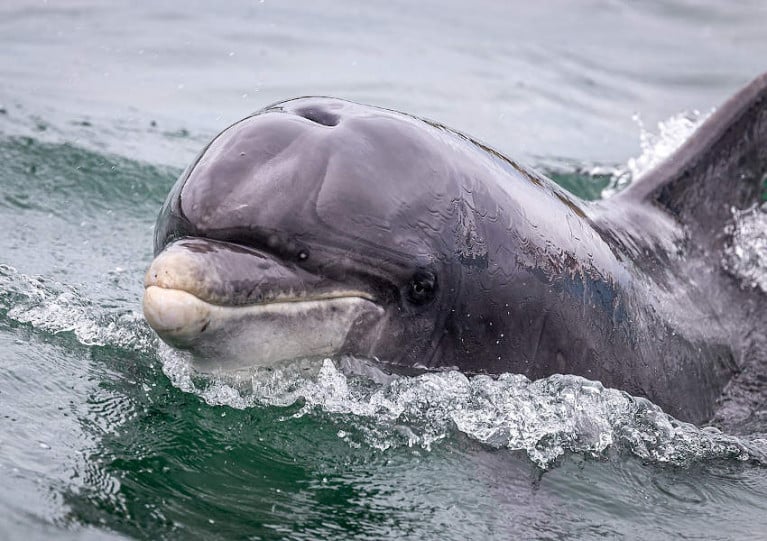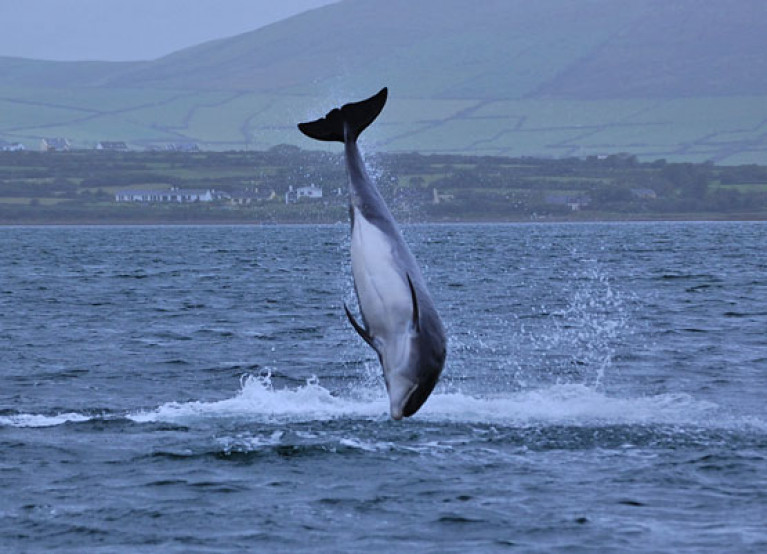Displaying items by tag: Fungie
Dingle Hosting Day to Remember Fungie’s Legacy One Year On from Dolphin’s Disappearance
Dingle will host a special commemoration for Fungie the dolphin this month, as the Irish Independent reports.
Fungie took up residence in the Co Kerry harbour in 1983 and over the decades since formed the backbone of the town’s tourism-based economy.
But the bottlenose dolphin disappeared in mid October last year — and marine experts suggest he either died or relocated to waters where he’s yet to be traced.
One year on and a special commemoration day is planned in Dingle on Sunday 17 October to celebrate the dolphin who put the town on the map.
Free boat trips around the harbour entrance will be offered, with donations welcome to support Dingle Coast and Rescue and Mallow Search and Rescue.
“We want to celebrate the magic that Fungie brought to Dingle and to people from all over the world,” said local resident Jamie Flannery.
The Irish Independent has much more on the story HERE.
Dingle’s boatmen have been hit hard by the double whammy of pandemic restrictions on the tourism trade and the disappearance of Fungie last autumn.
But as the Business Post reports, the boatmen of the Kerry Gaeltacht town have directed their ire at the Government for what they believe is a failure to support their industry — such as the absence of a freeze on harbour fees.
Dingle Sea Safari owner Jimmy Flannery says: “It looks like, once again, when it comes to the marine sector, they don’t give a damn.”
The Business Post has much more on the story HERE.
The Irish Whale and Dolphin Group (IWDG) has said it is “irresponsible to raise peoples' hopes” that a dolphin spotted off West Cork in recent days might be Dingle’s missing resident bottlenose, Fungie.
Cork Beo reported on Sunday (11 April) on video recorded off the Old Head of Kinsale of a playful solitary dolphin which has sparked optimism that Fungie has reappeared some six months since he vanished from Dingle Harbour, his home since 1983.
But the IWDG has moved to play down such hopes, reminding that bottlenose dolphins like Fungie “are abundant and widespread throughout Irish coastal waters”.
It added: “While the IWDG are surprised at this individual’s behaviour around the boat it was recently filmed from, it is way too early to speculate that this dolphin is Fungie.
“The IWDG have validated 13 sightings of bottlenose dolphins off the Irish coast already this month (April) from Co Kerry to Co Louth.”
The group is awaiting clearer images of the dolphin’s tail fluke or dorsal fin before it makes any confirmed identification.
“The IWDG feel it is irresponsible to raise peoples’ hopes that this might indeed be Fungie, while current evidence merely shows it to be a bottlenose dolphin behaving in an unexpected fashion,” it said.
It’s not the first video of a frolicking dolphin to cause a stir in recent weeks, as footage captured in Galway Bay last month raised hopes that Fungie had relocated along the West Coast.
A video circulating online of a dolphin frolicking in Galway Bay is “extremely unlikely” to be the missing bottlenose Fungie, as the Irish Examiner reports.
The footage sparked hopes that Dingle’s famous long-term marine wildlife resident had reappeared nearly five months after his last sighting in the Co Kerry town.
But Nic Slocum of Whale Watch West Cork said that while it was impossible to be “absolutely sure”, there were enough indications that it was not the same animal as Fungie, with a smaller body and shorter beak.
“They both jump, and they both jump in that way. And I know everybody got a little bit excited because they thought it might be Fungie showing himself again,” Slocum said.
“From my perspective, I would say that it is extremely unlikely to be Fungie and far more likely to be a short beak common dolphin.”
The Irish Examiner has more on the store HERE.
As hopes fade of Fungie’s return to Dingle, research suggests that “missing” dolphins are more likely to have migrated than died.
Dolphins in the Shannon estuary which were initially presumed to have perished had in fact moved to nearby bays, according to research published by the Irish Whale and Dolphin Group (IWDG).
The study by Kim Ellen Ludwig of Galway-Mayo Institute of Technology (GMIT) found that the “missing” dolphins had “emigrated” to Tralee and Brandon bays in Kerry, south of the Shannon estuary.
The Shannon estuary’s population of around 140 dolphins provided a good sample for the study, which Ms Ludwig conducted in collaboration with the IWDG.
The IWDG – a registered charity founded by Dr Simon Berrow in 1990 - has been monitoring the Shannon bottlenose dolphins since 1993. It constitutes the longest running whale or dolphin study in Ireland.
The group recently explored its 27-year old identification dataset to see if it could answer the question as to when to consider a dolphin as “dead” rather than missing.
Dolphins and whales are highly mobile, ranging thousands of kilometres.
Survival of young dolphins or calves is easier to monitor when they are dependent on their mothers for survival and is more difficult when calves are weaned.
The study with Ms Ludwig indicated that survival rate was 95.6% for “well-marked individual dolphins”- which means around 4.4% of adult dolphins die each year.
“For less well-marked individuals, survival increases to 5.8%, due to the higher chance a dolphin is “missed” during surveys,” it says.
The IWDG says that Ms Ludwig’s work highlights “a really important confounding factor, that of emigration outside the Shannon estuary to adjacent Tralee and Brandon bays”.
The dolphins had been presumed dead as these two bays are not routinely sampled during monitoring surveys.
Only by extending their surveys, did the IWDG realise that the dolphins were alive and well, and had extended their range.
Scientists with the IWDG are now recommending that the boundary of the lower river Shannon special area of conservation be extended to protect the important habitats of the bottlenose dolphins.
The group also suggests the area could be designated as a marine protected area as an alternative strategy.
In relation to Fungie, estimated to be 37 years old, the IWDG says that “as the time increases without a sighting and the search effort continues", it is "more likely" that he is dead rather than just simply missing.
However “his legacy will live on for years”, it says.
Fungie’s Life in Dingle ‘Was Never Going to Last’
“It’s better this way, rather than Fungie wash up dead on the shores of Dingle Bay, [that he] just disappear.”
That’s the message from the Irish Whale and Dolphin Group’s (IWDG) chief executive as nearly two weeks have passed since Dingle’s longtime resident dolphin was last seen in the Co Kerry village.
Writing on the IWDG website, Dr Simon Berrow reminisces about his own encounters with the friendly bottlenose since his own arrival in the West of Ireland in 1988.
And he believes that Fungie has been an inspiration some of the millions who have witnessed him over the years to pursue further interests in marine matters.
But Dr Berrow is also brutally honest about the region’s over-reliance on the marine wildlife singleton as a draw for visitors.
“Building an international tourism product on a single dolphin was never going to last,” he says. “It was unsustainable.”
Dingle Hopes Against Hope for Well-Being of Fungie the Dolphin
Everyone in Dingle - and beyond too, in a much wider world of shared joy in his existence - everyone knew that some day, it was going to happen. Some day, the sad but inevitable feeling was going to take hold and gradually be accepted that Fungie, the much–loved Dingle dolphin, has gone - and gone for good not just from Dingle, but from this world of ours.
For 37 years, his life-enchancing and charismatic presence has established a relationship between humans and a cetacean which has been seen elsewhere, but somehow never with the sheer intensity, transcendental delight and very Irish way that Fungi has made possible in Dingle Harbour. No-one who has ever experienced it will ever forget it. But now it may well be that memories are all we’ll have, and this new gem of reporting on RTE News from Sean Mac an tSithigh will speak from the heart for everyone who has met Fungie at his wonderful best.
Some wonderfully nostalgic footage of the early days of Fungie here... might give a sense of the affection the local community has for this special dolphin. https://t.co/yKVKMKIGvx
— Seán Mac an tSíthigh (@Buailtin) October 20, 2020
’No News Is Good News’ as Hunt for Missing Dolphin Fungie Pauses Amid Poor Weather
Poor weather off the Kerry coast has put on hold the search for Fungie the dolphin who has been missing from his Dingle home for almost a week, according to the Guardian.
Yesterday, Sunday 18 October, RTÉ News reported that divers from Mallow Search and Rescue has joined the search to explore coves around Dingle Harbour amid growing concern for Fungie’s wellbeing.
The bottlenose dolphin has been resident in the village harbour since 1983, rarely straying far from its environs — and never for this length of time.
There was an unconfirmed report of a sighting last Thursday, as local fisherman Gary Hand suggested the marine wildlife favourite was feeding with other dolphins further out in Dingle Bay.
That’s one of the theories being shared by local boatmen — some of whom also suggest that the solitary Fungie may be in hiding from dolphin pods and whales encroaching on his usual inshore waters.
“There’s still hope,” said boatman Gary Brosnan. “If Fungie has died there’s a good chance we’d have found him in one of the inlets or caves. No news is good news.”
Dingle boatmen have a number of theories re Fungie’s disappearance:
— Seán Mac an tSíthigh (@Buailtin) October 19, 2020
Theory 1: Fungie has gone out to sea following feed. An easterly wind off the land tends to drive sprat and other feed away from the coast. Possible, but Fungie has never been missing this long. 1/4... pic.twitter.com/gPyhH3KehC
‘Missing’ Fungie Reportedly Resurfaces In Dingle Bay
Reports of the disappearance of Dingle’s resident dolphin Fungie this week appear to have been greatly exaggerated, as a cetacean matching his description was spotted by a local fisherman.
Paul Hand tells RTÉ News that he is “one thousand percent certain” the bottlenose dolphin that followed his boat into Dingle Bay yesterday (Thursday 15 October) was Fungie, who has made his home in the Co Kerry village since the early 1980s.
Fungie aroused some concern on Wednesday when he failed to appear as usual in the harbour, with unusual movements said to be “unlike him”.
But Hand suggests the dolphin has simply been following boats out into the bay and staying to feed and spend time with a pod of his own kind — following a lonely summer in the absence of the area’s usual tourist trade.
RTÉ News has more on the story HERE.
Long-Living Fungie The Dolphin Is A Record-Breaker
Dingle’s resident dolphin Fungie is one of the longest living solitary cetaceans in the world, according to a new report from wildlife experts.
The second edition of the Lone Rangers report identifies Fungie — who has been a fixture of Dingle in Co Kerry since 1984 — as the longest living solitary cetacean in European waters.
In the global list, Fungie is second only to Jojo, a fellow bottlenose dolphin of the Turks and Caicos Islands in the West Indies who has been dated back to 1980.
“Fungie is a very engaging dolphin who has become an international phenomenon with people travelling from near and far just to catch a sight of this enigmatic marine mammal”, said Marine Connection director Margaux Dodds, a co-author of the report.
The Irish Examiner has more on the story HERE.


























